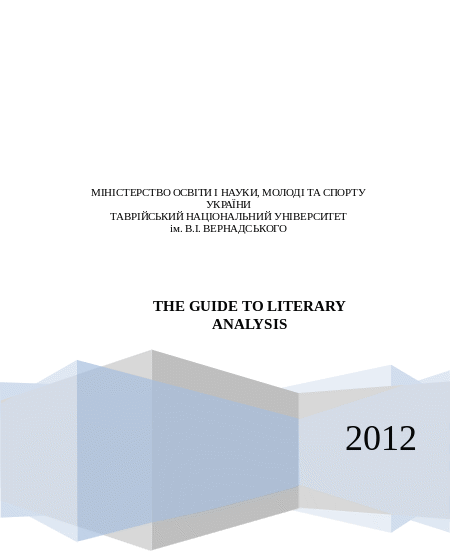
- •Полховська о.В., мазіна о.М., князева н.А. The guide to literary analysis навчально-методичний посібник з комплексного аналізу художнього тексту
- •Contents
- •Introduction
- •I. Theoretical fundamentals of literary analysis
- •1.1. Notion of style. Genre
- •1.2. Social and cultural background
- •Values, beliefs and attitudes.
- •1.3. Thematic formation. Gist and problem identification
- •1.4. Author’s tone and intent
- •1.5. Composition and content organization. Types of narration
- •1.6. Point of view. Voice and focalisation
- •1.7. Setting and environment
- •To hold personal significance to spark memories of past experiences
- •Characterisation
- •Language in use for analysis
- •The characters have distinct personalities, histories, values and motivations.
- •Language and imagery. Individual style of writing
- •Language in use for analysis
- •The imagery employed by the writer
- •II. Strategies
- •Reread and reflect. Review your writing.
- •Standards for evaluation An effective literary analysis…
- •Theoretical approaches
- •Author-oriented approaches
- •Context-oriented approaches
- •Text-oriented approaches
- •Reader-oriented approaches
- •References
- •Appendix 1. Glossary of stylistic terms
- •- To make some part of a sentence more conspicuous.
- •Helpful linking words and devices

МІНІСТЕРСТВО ОСВІТИ І НАУКИ, МОЛОДІ ТА СПОРТУ УКРАЇНИ ТАВРІЙСЬКИЙ НАЦІОНАЛЬНИЙ УНІВЕРСИТЕТ ім. В.І. ВЕРНАДСЬКОГО
Кафедра англійської філології
Полховська о.В., мазіна о.М., князева н.А. The guide to literary analysis навчально-методичний посібник з комплексного аналізу художнього тексту
для студентів денної та заочної форм навчання
спеціальності 6.02030302 «Англійська мова та література»
освітньо-кваліфікаційного рівня «бакалавр»
Сімферополь 2012
Друкується згідно з рішенням редакційно - видавничої ради ТНУ від
Укладачі: зав. кафедри англійської філології ТНУ,
к.ф.н., доц. Полховська О.В., к.ф.н., доц. Мазіна О.М.,
к.ф.н., доц. Князева Н.А.
Рецензенти:
Доктор філологічних наук, професор, декан факультету перекладознавства Херсонського державного університету Демецька Владислава Валентинівна
Доктор філологічних наук, доцент кафедри методики викладання філологічних дисциплін Таврійського національного університету ім. В.І. Вернадського Орєхов Володимир Вікторович
Доктор філологічних наук, доцент кафедри філології Кримського республіканського інституту післядипломної освіти Резник Оксана Володимірівна
Кандидат філологічних наук, доцент кафедри англійської філології Дніпропетровського національного університету ім. Олеся Гончара
Олена Олексіївна Конопелькіна
Contents
Introduction……………………………………………………………………..6
Theoretical fundamentals of literary analysis………………………….7
Notion of style. Genre…………………………………………………….7
Social and cultural background…………………………………………9
Thematic formation. Gist and problem identification………………..11
Author’s tone and intent………………………………………………..14
Composition and content organization. Types of narration………….17
Point of view. Voice and focalization………………………………..…23
Setting and environment………………………………………………..28
Characterisation…………………………………………………………30
Language and imagery. Individual style of writing…………………...35
Strategies…………………………………………………………………39
Standards for evaluation………………………………………………..40
Theoretical approaches………………………………………………….41
References……………………………………………………………………….48
Appendix 1. Glossary of Stylistic terms…………………………………….....49
Appendix 2. Helpful linking words and devices……………………...……….60
Introduction
The aim of The Guide to Literary Analysis is to bring together existing models and approaches from literary studies, to provide methods, tools and procedures for active exploring literary works through reading, response and analysis, which will bring out students’ interpretation and account for the ways in which the work produces the meanings found in it. The ultimate end of a literary analysis is, first and foremost, a deeper understanding and a fuller appreciation of how a literary work communicates a particular set of meanings for a reader, how the resources of literature are used to create the meaningfulness of the text.
Text analysis is an active enterprise that requires imagination, effort, and engagement with a text; it is a kind of interpretation enlarging and deepening readers’ experience – as they interact with a text – in order to come to some conclusion and to gain an earned opinion. It is ongoing and recursive process of accumulating opinions, constant revising and modifying them.
Any text has always been realized as belonging to cross-cultural communication where meaning is not made with language alone but accomplished by some kinds of social and cultural presuppositions. To make sense of the text, a reader is to be interested in the actual processes of decoding and interpretation. Reasonable interpretation of the text shows the understanding of its social context, and how social conventions have helped determine its meaning. In effect, a work of literature is not seen as eternal and timeless but is situated historically, socially, intellectually, written at a particular time, with some intent, with particular cultural, personal, gender, racial, class and other perspectives.
In a literary work the message is delivered through a text (context), subtext (implication, hidden associations) and super-text (connection between the literary text and reality). With the purpose to uncover it, one needs to work out through various strategies that let us know what kind of text it is – its genre, grammar and syntax, rhetoric (way of persuading and building up an argument), narration, images, subject matter, all the ways in which the meaning is constructed.
Doing the analysis one needs to be clear about the model to use, because that has serious implications for how one understands the presented information and what the interpretations are. This means that before plunging straightaway into analysis there should be considered the assumptions about the text and the relations it has with the wide context and the reader to make sure they are at work.
